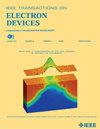利用 GA-BP 神经网络优化设计 340-GHz 行波管的多级凹陷集电极
IF 2.9
2区 工程技术
Q2 ENGINEERING, ELECTRICAL & ELECTRONIC
引用次数: 0
摘要
本文设计了用于 340 GHz 行波管(TWT)的三级消沉式集热器,并完成了热分析以测试其热可靠性。为了快速完成高效率、低回流率和散热性的集热器设计,结合了反向传播(BP)神经网络(NN)和多目标优化算法来优化集热器。首先,利用 BP 神经网络在收集器的十个输入参数和三个目标值之间构建一个近似计算模型:1)回收效率;2)回流率;3)热平衡。然后,使用非支配排序遗传算法 III (NSGA-III) 为三个目标值找到帕累托最优解。所提方法的最佳回收效率为 88.17%,回流率为 0.09%,集热器内部温差仅为 16~^{\circ }$ C,实现了热平衡。它为快速准确地设计 340 GHz TWT 的多级衰减集热器 (MDC) 提供了参考。本文章由计算机程序翻译,如有差异,请以英文原文为准。
GA-BP Neural Networks for Optimal Design of Multistage Depressed Collector for 340-GHz Traveling Wave Tubes
In this article, a three-stage depressed collector for a 340-GHz traveling wave tube (TWT) is designed, and thermal analysis is finished to test the thermal reliability. To quickly finish the design of the collectors with high efficiency, low reflux rate, and heat dissipation, the back-propagating (BP) neural network (NN) and a multiobjective optimization algorithm are combined to optimize the collector. First, BP NN is used to construct an approximate calculation model between the ten input parameters of the collector and the three target values: 1) recovery efficiency; 2) reflux rate; and 3) heat balance. Then, the nondominated sorting genetic algorithm III (NSGA-III) was used to find Pareto optimal solutions for the three targets. The proposed method’s optimal recovery efficiency is 88.17%, the reflux rate is 0.09%, and the temperature difference inside the collector is only
$16~^{\circ }$
C, achieving thermal balance. It provides a reference for the fast and accurate design of a multistage depressed collector (MDC) of a 340-GHz TWT.
求助全文
通过发布文献求助,成功后即可免费获取论文全文。
去求助
来源期刊

IEEE Transactions on Electron Devices
工程技术-工程:电子与电气
CiteScore
5.80
自引率
16.10%
发文量
937
审稿时长
3.8 months
期刊介绍:
IEEE Transactions on Electron Devices publishes original and significant contributions relating to the theory, modeling, design, performance and reliability of electron and ion integrated circuit devices and interconnects, involving insulators, metals, organic materials, micro-plasmas, semiconductors, quantum-effect structures, vacuum devices, and emerging materials with applications in bioelectronics, biomedical electronics, computation, communications, displays, microelectromechanics, imaging, micro-actuators, nanoelectronics, optoelectronics, photovoltaics, power ICs and micro-sensors. Tutorial and review papers on these subjects are also published and occasional special issues appear to present a collection of papers which treat particular areas in more depth and breadth.
 求助内容:
求助内容: 应助结果提醒方式:
应助结果提醒方式:


